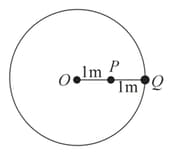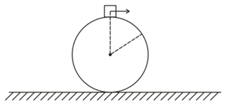Kinematics of Circular Motion
Kinematics of Circular Motion: Overview
This Topic covers sub-topics such as Uniform Circular Motion, Kinematics of Circular Motion, Circular Motion with Variable Angular Acceleration, Circular Motion with Decreasing Speed and, Circular Motion with Increasing Speed
Important Questions on Kinematics of Circular Motion
A particle of mass M is moving in a horizontal circle of radius R with uniform speed V. When it moves from one point to a diametrically opposite point, its :
A hemispherical bowl of radius is rotating about its own axis (which is vertical), with an angular velocity . A particle of mass on the frictionless inner surface of the bowl is also rotating with the same . The particle is at a height from the bottom of the bowl.
Obtain the relation between and . What is the minimum value of needed, in order to have a non-zero value of ?
An electric line of force in the plane is given by the equation . A particle with unit positive charge, initially at rest at the point in the plane, will move along the circular line of force.
A particle describes a horizontal circle in a conical funnel whose inner surface is smooth with the speed of . What is the height (in ) of the plane of the circle from the vertex of the funnel?
The tangential velocity of a body in a non-uniform circular motion varies as with the radius being equal to . What is the angular acceleration at in ?
Two spheres of equal masses are attached to a string of length as shown in figure. The string and the spheres are then whirled in a horizontal circle about at a constant rate. What is the value of the ratio of the tension in the string between and with the tension in the string between and ?

A particle is acted upon by a force of constant magnitude which is always perpendicular to the velocity of the particle. The motion of the particle takes place in a plane. It follows that
A stone tied to one end of rope and rotated in a circular motion. If the string suddenly breaks, then the stone travels
Starting form rest, a particle rotates in a circle of radius m with an angular acceleration α = π/4 rad/s2. The magnitude of average velocity of the particle over the time it rotates quarter circle is
In a carnival ride the passengers travel in a circle of radius 5.0 m, making one complete circle in 4 s. What is the acceleration?
The angular velocity of the minute hand of a clock is :
Which of the following statements about the uniform circular motion is true?
To enable a particle to describe circular motion the angle between its velocity and acceleration is given by
Which one is the correct relation between the magnitude of linear acceleration and angular acceleration in circular motion of radius of circular path.
Assume is linear acceleration and is angular acceleration.
An object is at the top of a smooth sphere which is kept fixed. As object slides down after being given a negligible side push, magnitude of acceleration of object during its motion till it reaches ground.

If a particle moves with an acceleration, then which of the following can remain constant ?
A particle moves in x-y plane according to rule x = asinωt and y = acosωt. The particle follows:
A particle moves in a horizontal circle with a speed of in a conical funnel whose inner surface is smooth. Find the height of the plane of circle from vertex of the funnel.
Two spheres are tied to an ideal string of length and whirled in a horizontal circle at a constant rate as shown in the figure. What is the value of the ratio

Find the acceleration of the stone which is tied to the end of a long string and whirled in a horizontal circle with a constant speed. It is also known that the stone makes revolutions in .
